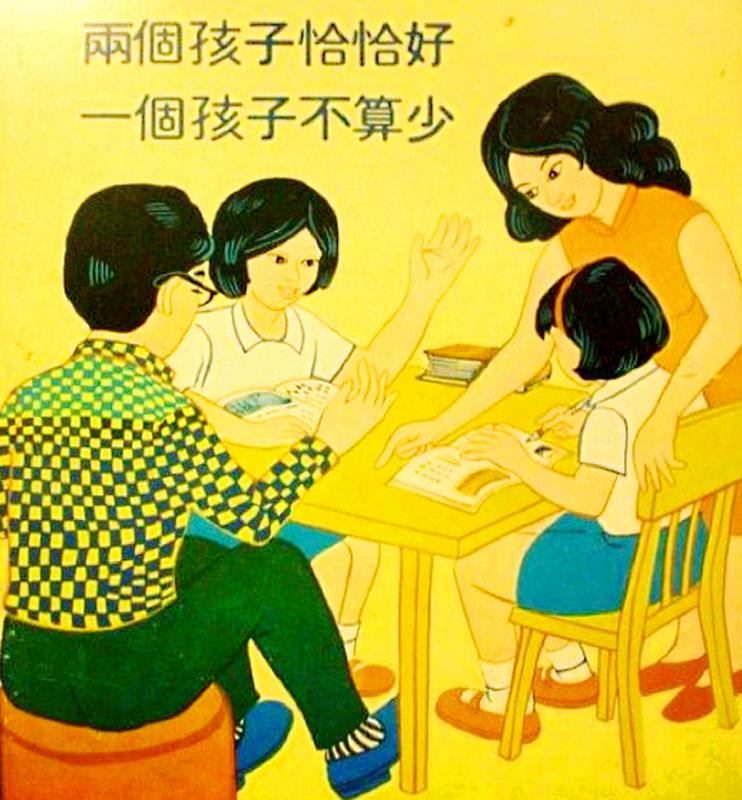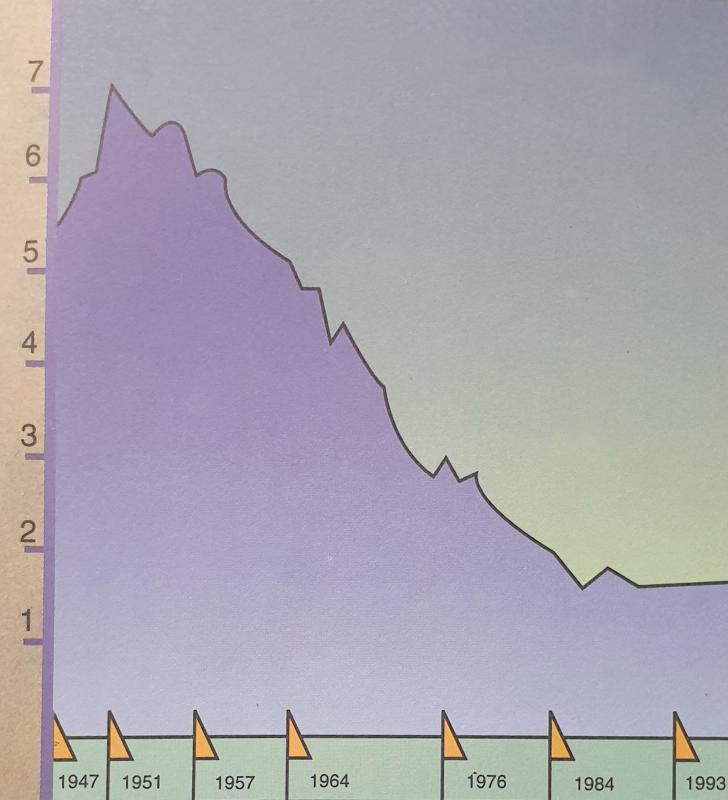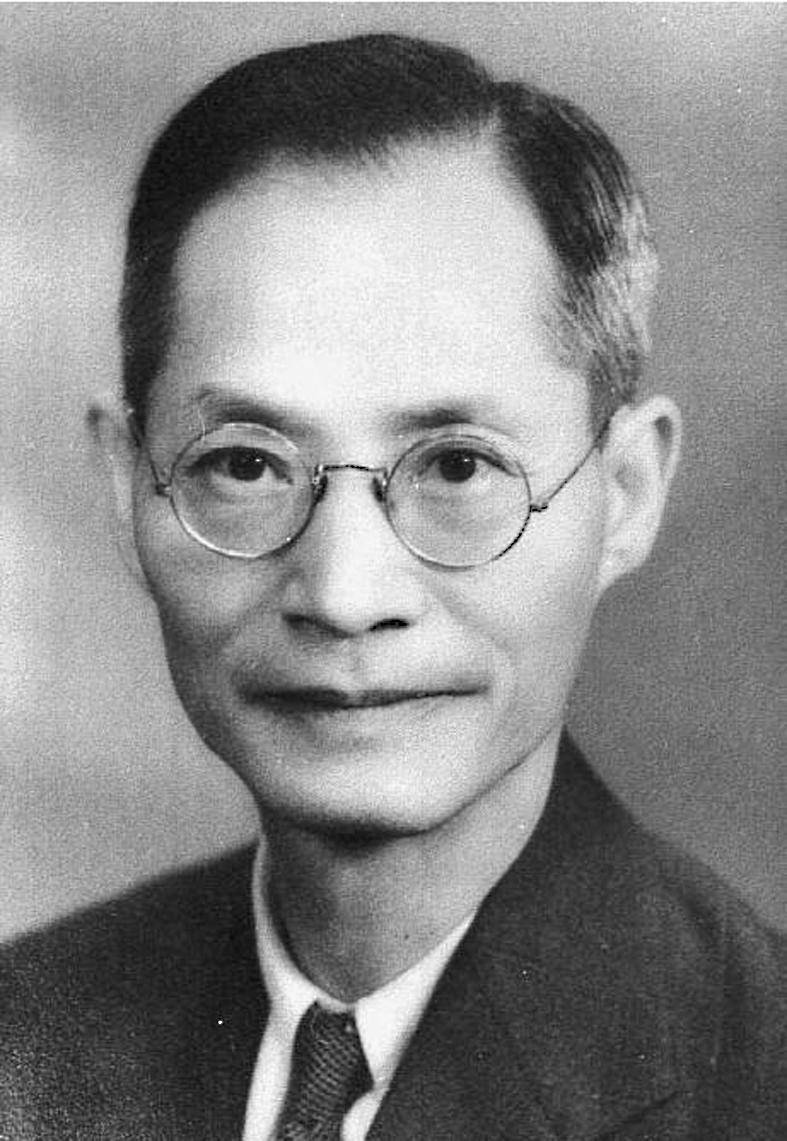June 15 to June 21
The slogan “One [child] is never too little, two [children] is just enough” (一個不嫌少,兩個恰恰好) was devised in 1971 to urge people to have fewer kids, a stark contrast to the government’s efforts to drive up the birthrate today.
Socioeconomic changes caused the birthrate to drop below targeted levels in the mid-1980s, and the department of health (today’s Ministry of Health and Welfare) in 1996 revised the slogan to: “Two [children] are just enough, three [children] are never too plenty” (兩個恰恰好,三個不嫌多).

Photo courtesy of Amigororo
It hasn’t worked. Ministry of Interior statistics released last week show that Taiwan is on track to experience negative population growth for the first time this year, and the population is estimated to drop to 20 million by 2050.
The nation experienced a population boom during the early days of Chinese Nationalist Party (KMT) rule following World War II. In addition to the influx of refugees, soldiers and government officials from China, people were encouraged to have more children to support the war effort against the Chinese Communist Party.
But with concerns about overpopulation growing among officials, the government implemented a series of family planning and birth control policies in the 1960s. Having no more than two children and not discriminating between boys or girls was the centerpiece of the campaign, with the slogans remaining familiar catchphrases for most Taiwanese.

Photo courtesy of Amigororo
A TABOO SUBJECT
The nation’s birth control efforts were so successful that the US-based Population Action International ranked it first in 1987, 1992 and 1997 among 95 developing countries for family planning.
But in the beginning, it wasn’t so easy to convince the government. Chang Ming-cheng (張明正), who spearheaded the now defunct Taiwan Provincial Institute of Family Planning, recalls: “Not only was there no policy or law to support birth control, government, military, academic and religious leaders were all against it. The myriad reasons included contradicting [KMT founder] Sun Yat-sen’s (孫逸仙) teachings, affecting the source of troops and opposing traditional ethics and morals.”

Photo courtesy of Taiwan Family Planning Institute
In Chinese culture, it was a virtue to have many descendants.
Sino-US Joint Commission on Rural Reconstruction chairman Chiang Meng-ling (蔣夢麟) was the first official to openly support birth control, although with US support civic groups had been offering limited family planning in rural villages since 1954.
When the commission was established in Taiwan in 1949, its members, including Chiang, were in favor of boosting agricultural production to deal with the population increase. As long as they used scientific methods and industrialization to upgrade the industry, Taiwan would be fine for the next 30 years, Chiang wrote in 1953.

Photo courtesy of Wikimedia Commons
As a result, Taiwan averaged 6.3 births per woman between 1951 and 1961. Chiang changed his mind after taking a tour of rural Taiwan and seeing people living in overcrowded, squalid households with a high child mortality rate. US representatives from the commission also noted that Taiwan couldn’t sustain its population growth rate, but most Taiwanese officials remain unconvinced.
By August 1958, then-provincial governor Chou Chih-jou (周至柔) showed signs of relenting: “From a government standpoint, we will not promote birth control. But from the people’s point of view, whether for economic or other reasons, we will not prohibit birth control either.”
In 1959, Chiang held a press conference to present his paper, “Let us face the increasingly urgent population problem of Taiwan,” (讓我們面對日益迫切的台灣人口問題), urging the government to focus on the quality instead of quantity of the population, and warning that rampant development and growth will upset the balance of the environment and deplete natural resources.

Photo courtesy of Chunghwa Post
One of Chiang’s main opponents was the Catholic Church, which, in addition to religious reasons, cited the teachings of Sun Yat-sen, a staunch proponent of population growth to strengthen the nation. This belief was later called into question when Sun’s son, Sun Fo (孫科) assured fellow officials that birth control did not contradict his father’s ideals.
An adamant Chiang proclaimed that he would “advocate for birth control even if I lose his head.”
The first government-sponsored family planning initiative was launched in 1961 in Nantou County, but it was called “pre-pregnancy health” to avoid contradicting the government’s stance. It targeted women who had four or more children and encouraged them to use contraception. It also urged them to wait between pregnancies.
The program soon expanded to other counties. Meanwhile, concerns over the post-World War II population explosion grew in the West. With support from the Rockefeller Foundation’s Population Council, the Taiwan Population Study Center was established in September 1961. It introduced to Taiwan the Lippes Loop and other intrauterine contraceptive devices. Until the government included the condom in its recommended methods in 1970, birth control was mainly targeted toward women.
In 1964, the government announced its support for birth control and launched the first nationwide family planning program.
‘3-3-3-3-3’ GUIDELINES
The 1967 “3-3-3-3-3” guidelines were widely disseminated through the media: wait three years after marriage to have children, allow three years between each pregnancy, refrain from having more than three children and stop giving birth after the age of 33.
In 1971, the guidelines were changed to emphasize having no more than two children, and that boys and girls are equally favorable. Between 1961 and 1981, the nation’s fertility rate fell from 5.59 births per woman to 2.46.
Despite the success, the government took on a more urgent tone regarding the two-child recommendation in the early 1980s due to changes in society.
“This is not an idealistic slogan, it’s an urgent need,” a pamphlet from 1984 states. Overpopulation had led to fierce competition, which meant exponentially higher child-rearing costs as parental expectations rose.
“Traditionally, as long as the parents provide for their basic needs, their children will ‘naturally’ mature. That does not fit today’s society anymore … in addition, ‘sacrificing everything for one’s children’ is an outdated concept as parents should also be able to enjoy a quality life.”
By 1986, the total fertility rate had dropped to 1.68 births per woman — dipping below the two-child recommendation. And it would continue to fall. In the late 1990s, the government started worrying about the prospects of an aging society. They began urging people to have three children again — but nothing could reverse the tide, resulting in today’s predicament.
Taiwan in Time, a column about Taiwan’s history that is published every Sunday, spotlights important or interesting events around the nation that have anniversaries this week.

US President Donald Trump may have hoped for an impromptu talk with his old friend Kim Jong-un during a recent trip to Asia, but analysts say the increasingly emboldened North Korean despot had few good reasons to join the photo-op. Trump sent repeated overtures to Kim during his barnstorming tour of Asia, saying he was “100 percent” open to a meeting and even bucking decades of US policy by conceding that North Korea was “sort of a nuclear power.” But Pyongyang kept mum on the invitation, instead firing off missiles and sending its foreign minister to Russia and Belarus, with whom it

When Taiwan was battered by storms this summer, the only crumb of comfort I could take was knowing that some advice I’d drafted several weeks earlier had been correct. Regarding the Southern Cross-Island Highway (南橫公路), a spectacular high-elevation route connecting Taiwan’s southwest with the country’s southeast, I’d written: “The precarious existence of this road cannot be overstated; those hoping to drive or ride all the way across should have a backup plan.” As this article was going to press, the middle section of the highway, between Meishankou (梅山口) in Kaohsiung and Siangyang (向陽) in Taitung County, was still closed to outsiders

Many people noticed the flood of pro-China propaganda across a number of venues in recent weeks that looks like a coordinated assault on US Taiwan policy. It does look like an effort intended to influence the US before the meeting between US President Donald Trump and Chinese dictator Xi Jinping (習近平) over the weekend. Jennifer Kavanagh’s piece in the New York Times in September appears to be the opening strike of the current campaign. She followed up last week in the Lowy Interpreter, blaming the US for causing the PRC to escalate in the Philippines and Taiwan, saying that as

The Chinese Communist Party (CCP) has a dystopian, radical and dangerous conception of itself. Few are aware of this very fundamental difference between how they view power and how the rest of the world does. Even those of us who have lived in China sometimes fall back into the trap of viewing it through the lens of the power relationships common throughout the rest of the world, instead of understanding the CCP as it conceives of itself. Broadly speaking, the concepts of the people, race, culture, civilization, nation, government and religion are separate, though often overlapping and intertwined. A government